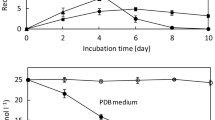Abstract
Removal and degradation of pentachlorophenol (PCP) by Phanerochaete chrysosporium in static flask cultures was studied using ammonium lignosulphonates (LS), a waste product of the papermill industry, as a carbon and nitrogen source. After 3 days, cultures of P. chrysosporium grown in either a 2% LS (nitrogen-sufficient) medium or a 0.23% LS and 2% glucose (nitrogen-deficient) medium removed 72 to 75% of PCP, slightly less than the 95% removal seen using nitrogen-deficient glucose and ammonia medium. PCP dehalogenation occurred despite the fact that extracellular enzyme (LiP) activity, measured by a veratryl alcohol oxidation assay and by PCP disappearance in cell-free extracts, was inhibited by LS. This inactivation of LiP likely contributed to the lower percent of PCP dehalogenation observed using the LS media. In order to better understand the relationship between PCP disappearance and dehalogenation, we measured the fate of the chlorine in PCP. After 13 days, only 1.8% of the initial PCP added was recoverable as PCP. The remainder of the PCP was either mineralized or transformed to breakdown intermediates collectively identified as organic halides. The largest fraction of the original chlorine (58%) was recovered as organic (non-PCP) halide, most of which (73%) was associated with the cell mass. Of the remaining chlorine, 40% was released as chloride ion, indicating a level of dehalogenation in agreement with previously reported values.
Similar content being viewed by others
References
Alleman BC (1991) Degradation of pentachlorophenol by selected species of white rot fungi. Ph.D. dissertation, Dept. Of Civil Engin. & Engin. Mechanics, University of Arizona, Tucson
Alleman BC, Logan BE & Gilbertson RL (1992). Toxicity of pentachlorophenol to six species of white rot fungus as a function of chemical dose. Appl. Environ. Microbiol. 58: 4048–4050
Alleman BC, Logan BE & Gilbertson RL (1995) Degradation of pentachlorophenol by fixed films of white rot fungi in rotating tube bioreactors. Wat. Res. 59: 61–67
Archibald FS (1992) A new assay for lignin-type peroxidases employing the dye azure B. Appl. Environ. Microbiol. 58: 3110–3116
Armenante PM, Pal N & Lewandowski G (1994) Role of mycelium and extracellular protein in the biodegradation of 2,4,6-trichlorophenol by Phanerochaete chrysosporium. Appl. Environ. Microbiol. 60: 1711–1718
Bonnarme P & Jeffries TW (1990) Mn(II) regulation of lignin peroxidase and manganese-dependent peroxidase from lignin-degrading white rot fungi. Appl. Environ. Microbiol. 56: 210–217
Boominathan K, Dass SB, Randall TA, Kelley RL & Reddy CA (1990) Lignin peroxidase-negative mutant of the white-rot basidiomycete Phanerochaete chrysosporium. J. Bacteriol. 172: 260–265
Dorosetz CG, Dass SB, Reddy A & Grethlein HE (1990) Protease-mediated degradation of lignin peroxidase in liquid cultures of Phanerochaete chrysosporium. Appl. Environ. Microbiol. 56: 3429–3434
Glenn JK & Gold MH (1985) Purification and characterization of an extracellular Mn(II)-dependant peroxidase from the lignin-degrading basidiomycete Phanerochaete chrysosporium. Arch. Biochem. 242: 329–341
Jeffries TW, Choi S & Kirk TK (1981) Nutritional regulation of lignin degradation by Phanerochaete chrysosporium. Appl. Environ. Microbiol. 42: 290–296
Kirk TK, Schultz E, Connors WJ, Lorenz LF & Zeikus JG (1978) Influence of culture parameters on lignin metabolism by Phanerochaete chrysosporium. Arch. Micorbiol. 117: 277–285
Kirkpatrick N & Palmer JM (1989) A natural inhibitor of lignin peroxidase activity from Phanerochaete chrysosporium, active at low pH and inactivated by divalent metal ions. Appl. Microbiol. Biotechnol. 30: 305–311
Krivobok S (1994) Diversity in pheonol metabolizing capabilities in 809 strains of micromycetes. Microbiol. 17: 51–60
Kuwahara M, Glenn JK, Morgan MA & Gold MH (1984). Separation and characterization of two extracellular H2O2—dependent oxidases from lignolytic cultures of Phanerochaete chrysosporium. FEBS. 169: 247–250
Lamar RT & Dietrich DM (1992) Use of lignin-degrading fungi in the disposal of pentachlorophenol-treated wood. J. Indus. Microbiol. 9: 181–191
Lamar RT, Larsen MJ & Kirk TK (1990). Sensitivity to and degradation of pentachlorophenol by Phanerochaete spp. Appl. Environ. Microbiol. 56: 3519–3526
Lamar RT, Evans JW & Glaser JA (1993) Solid phase treatment of a pentachlorophenol- contaminated soil using lignin-degrading fungi. Environ. Sci. Technol. 27: 2566–2571
Lin J-E, Wang HY & Hickey RF (1990). Degradation kinetics of pentachlorophenol by Phanerochaete chrysosporium. Biotechnol. Bioengin. 35: 1125–1134
Linko S (1992) Production of Phanerochaete chrysosporium lignin peroxidase. Biotech. Adv. 10: 191–236
Linko S & Haapla R (1993) A critical study of lignin peroxidase activity assay by veratryl alcohol oxidation. Biotechnol. Tech. 7: 75–80
Logan BE, Alleman BC, Amy GL & Gilbertson RL (1994). Adsorption and removal of pentachlorophenolby white rot fungi in batch culture. Wat. Res. 28: 1533–1538
Mileski GJ, Bumpus JA, Jurek MA & Aust SD (1988) Biodegradation of pentachlorophenol by the white rot fungus Phanerochaete chrysosporium. Appl. Environ. Microbiol. 54: 2885–2889
Paszczynski A, Patsi-Grigsby MB, Goszcynski S, Crawford RL & Crawford DL (1992) Mineralization of sulphonated azo dyes and sulfanilic acid by Phanerochaete chysosporium and Streptomyces chromofuscus. Appl. Environ. Microbiol. 58: 3598–3604
Pellinen J, Joyce TW & Chang HM (1988) Decholorination of high-molecular weight chlorolignin by the white rot fungus Phanerochaete chrysosporium. Tappi. 9: 191–194
Rydholm SA (1965) Pulping Processes. Interscience Publishers, New York
Author information
Authors and Affiliations
Rights and permissions
About this article
Cite this article
Aiken, B.S., Logan, B.E. Degradation of pentachlorophenol by the white rot fungus Phanerochaete chrysosporium grown in ammonium lignosulphonate media. Biodegradation 7, 175–182 (1996). https://doi.org/10.1007/BF00058177
Accepted:
Issue Date:
DOI: https://doi.org/10.1007/BF00058177




